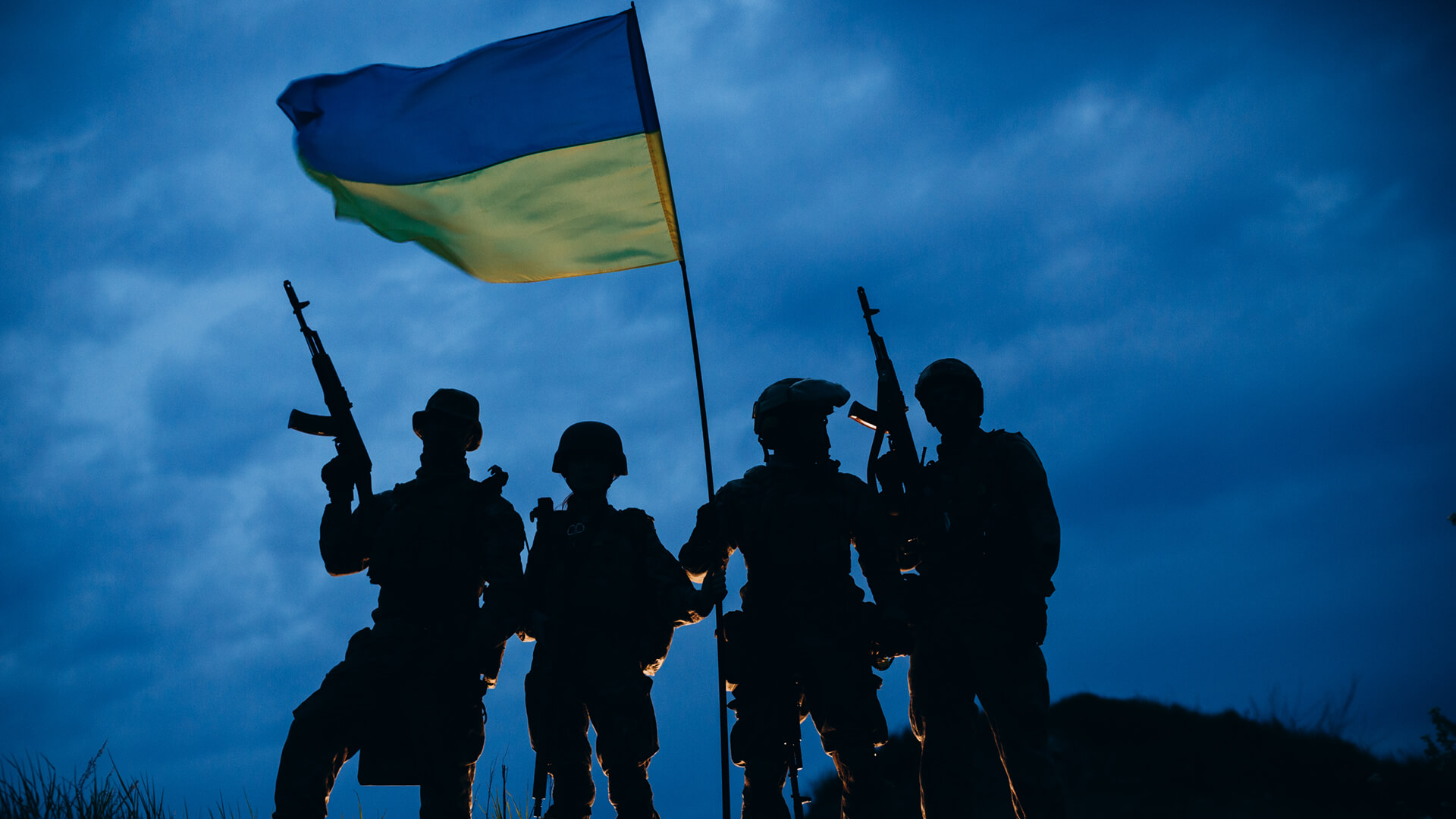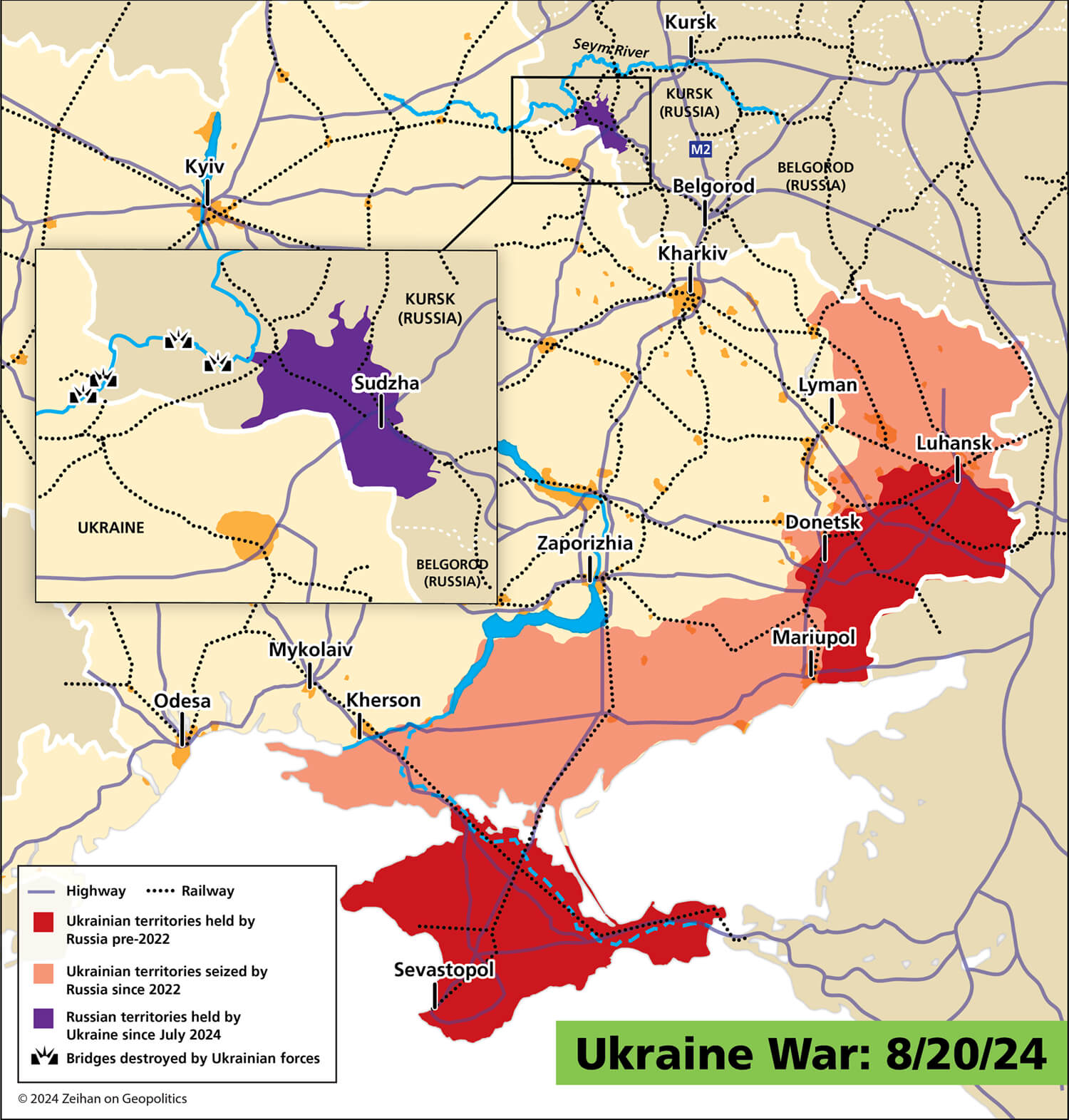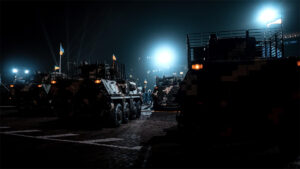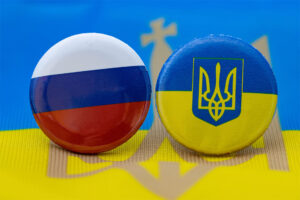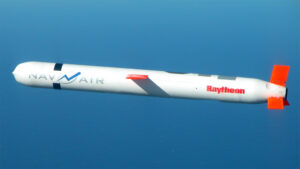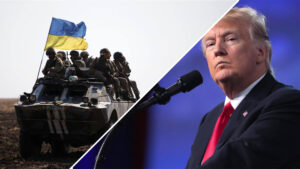Ukraine has made a significant push into Russian territory, capturing roughly 1,000 square kilometers within the Kursk province. The Ukrainians also destroyed a handful of bridges that will hinder Russia’s logistical support for Belgorod and complicate Russian reinforcement efforts.
Ukraine’s incursion into Kursk has Russia scrambling to pull together enough troops to counter the push, but the Russians lack the manpower and leadership necessary to effectively do so. This is a huge strategic gain for Ukraine, but it pales in comparison to the bigger learning here.
Despite Ukraine crossing into Russian territory, and dealing a huge blow to Russian forces, nukes haven’t flown. This might signal to the West that Russia’s bark is louder than its bite, and those nuclear threats may be just that…threats.
This could be a turning point in Western support for Ukraine and we could be seeing more operations in the near future.
Here at Zeihan On Geopolitics we select a single charity to sponsor. We have two criteria:
First, we look across the world and use our skill sets to identify where the needs are most acute. Second, we look for an institution with preexisting networks for both materials gathering and aid distribution. That way we know every cent of our donation is not simply going directly to where help is needed most, but our donations serve as a force multiplier for a system already in existence. Then we give what we can.
Today, our chosen charity is a group called Medshare, which provides emergency medical services to communities in need, with a very heavy emphasis on locations facing acute crises. Medshare operates right in the thick of it. Until future notice, every cent we earn from every book we sell in every format through every retailer is going to Medshare’s Ukraine fund.
And then there’s you.
Our newsletters and videologues are not only free, they will always be free. We also will never share your contact information with anyone. All we ask is that if you find one of our releases in any way useful, that you make a donation to Medshare. Over one third of Ukraine’s pre-war population has either been forced from their homes, kidnapped and shipped to Russia, or is trying to survive in occupied lands. This is our way to help who we can. Please, join us.
Transcript
Hey, everybody. Peter Zeihan here. Back from my backpacking trip. I’m back in Colorado, and today we are going to talk about the most recent evolutions in the Ukraine war, which are wildly significant. Let’s deal with this from the least important to the most. First of all, going into Russia itself—nobody invades Russia on a whim.
I mean, part of the problem that the Russians have always had expanding from Moscow is that there is no logical place to stop this within a thousand miles of them. So they expand, conquer some minorities, occupy them, try to crucify them, turn them into cannon fodder, and throw them at the next line of minorities.
And they continue this process over and over and over and over and over, until they eventually reach a geographic barrier that they can actually hunker down behind, which is typically like the Baltics, the Carpathians, and the Black Sea. It works until it doesn’t. What we’re seeing with Russia right now is that the demographic decline among the Russian ethnicity is so high that within a few years, they’re going to have problems occupying their own populations.
Anyway, anyone who wants to attack Russia has to do that in reverse. And even if you make it all the way to Moscow, that’s not all of the Russian Federation territory. You basically have to go until Russia is broken. And by Russia, I mean the population. We have the possibility of seeing that in the next 10 or 20 years, but we’re not there yet.
The incursion that the Ukrainians have made into Russia proper isn’t all that impressive from a territorial point of view. Basically, in the last two weeks, the Ukrainians have invaded Russia proper. They’ve taken over about 1,000 km² in the province of Kursk. The question is why? And what is next? Well, the Ukrainian plan seems to be to take a pretty sizable bite out of the territory.
They have already destroyed the three permanent bridges that are over the River Cem, which is an East-West river that cuts through Kursk Province. By doing that, they’ve made it very difficult for the Russians to reinforce the territories around where this incursion has been. We know that the Ukrainians are currently expanding on at least four different axes: northwest, northeast, north, and east.
In doing so, they’re basically looking to swallow, at least temporarily, about half the province—about 6,000 mi². To give you an idea of scale, the Donbas in the southeast, where most of the fighting has been concentrated for the last year and a half, and the Ukraine war combined, is about 20,000 mi². So, you’re talking about an area about a third of that territory.
The 1,000 square kilometers that the Ukrainians have captured so far is greater than the entirety of what the Russian army has achieved in the Donbas in the last 18 months. So, from a Russian point of view, this is a small amount of territory. From a Ukraine war point of view, it’s a huge amount of territory. And because those bridges are now out, the Russians can only resupply with pontoons.
Unlike hard bridges that require some pretty heavy weaponry to take out, pontoons can be taken out by much shorter-range things like artillery. And they are. So, the Russian ability to fight back has been relatively limited. The question is, how far can this be pushed? Why is it happening? Let’s start with the why. I have always identified the city of Belgorod as one of the cities that the Ukrainians have to neutralize if they’re ever going to win this war because it’s the tip of the spear for Russian forces. This is where, in the northern theater, all of their armies and all of their artillery are concentrated because it’s at the end of the logistical lines. It’s a big rail and road hub. Well, if the Ukrainians are capable of basically taking the southern half of Kursk Province, they take out most of the infrastructure that feeds into Belgorod.
So, it neutralizes a city of a million people without actually going in and conquering a city of a million people, which I’ve got to say is pretty clever if they can pull it off. And with the bridges now out of the equation, I’d say there’s an even chance that they’re going to be able to pull that off. However, this is the end of their deployable reserves.
The Russian strategy is basically to launch a lot of artillery assaults, send in a huge number of barely trained—if trained at all—conscripts to soak up ammo and pin Ukrainian defenders in place, and then follow up with more and more and more artillery. It’s a very slow, grinding process, but because the Russians have manpower superiority, it’s one that has been broadly effective, at least in keeping the Ukrainians from doing things like this.
It took the Ukrainians scraping up the last of their reserve units, along with some advanced units that were training with NATO for future operations. I don’t think they’ve got a very deep bench beyond this. But they have succeeded in doing what they’ve always wanted to do in this war, which is to trigger a war of movement in Kursk, in Russian territory, ironically, in a way that they haven’t been able to do on their own territory.
The counteroffensive that we’ve seen from Ukraine in the war so far in the Donbas and near Crimea has basically been hamstrung by Russian defensive lines. You’ve got multi-layered lines of tank emplacements, artillery emplacements, and most importantly, minefields, so that when the Ukrainians move into these areas and have to start to clear the mines, the Russians are able to call in artillery barrages, and the Ukrainians ultimately have to decamp for other locations where they’re not going to die.
That doesn’t apply in Kursk. Those defensive lines are in Belgorod, but you don’t have them in Kursk. So, the Ukrainians have been able to basically locate a battlefield that plays to their strengths rather than the Russian strengths. And they’re kicking some serious ass. The problem is they probably don’t have enough men to fully take advantage of it.
But neither do the Russians have the men necessary to eject the Ukrainians. For the last two and a half years, the Russians have spent most of their logistical efforts in building a pipeline of men and material. Basically, they scrape together whatever men they can forcibly draft from the population, put guns in their hands, and throw them to the front.
To do this in a way that does not trigger a political crisis, they can only do it so fast and only in so many places. They prefer to go to those occupied minority populations where they think the young men are disposable. And in fact, if they die, that’s actually a plus from the Russian point of view because it means they can’t rebel against Russian rule. But they’ve basically dragged all the people they can of the appropriate age group out of those zones.
And now the cupboard is getting dry.
The pipeline isn’t simply running low in terms of forces but in leadership. Putin has basically used every military commander that he has already that’s even remotely competent. And so, he’s just assigned one of his former bodyguards to run the operation in Kursk.
And you can imagine how well that’s going.
The Russians also now have 10,000 Ukrainians, including the Ukrainian support echelons, running around in Kursk. As a rule, the Russians have never attacked an area where they don’t enjoy at least a 3 to 1 manpower superiority. They prefer 7 to 1, and they don’t have the forces to put there.
So, their options are to either partially abandon the Donbas offensive or dig deep into the Russian population. What we’ve seen them do in the last two weeks is basically mobilize every military force they have left in the country, which is not a lot, and include the Pacific, the Baltic, and the Arctic theaters of what little security personnel remain and throw them into Kursk, in many cases untrained.
They’ve even raided the security forces around the cosmodrome in the Far East. And I’ve got to tell you, if your security force was designed to keep a launch pad safe, it’s probably not very good in the face of an Abrams barrel. There’s nothing left. They haven’t been able to find the 30,000 to 70,000 troops that they need in order to retake Kursk.
With the bridges gone, they can only approach from the east.
So, the Ukrainians are having a bit of a heyday at the moment, running around in Kursk, dealing with lightly armed and wildly untrained troops that don’t even have the benefit of large-scale artillery support. I don’t mean to suggest for a second that the Ukrainians are not taking casualties themselves. It’s an active war zone. I don’t have good data. I would be shocked if, in an offensive operation of this scale, they’re not taking heavy losses, especially in their armor. But the fact remains that the Ukrainians have found a way, relatively on the cheap, to play to their strengths, neutralize Belgorod, and change the narrative of the war.
Anyway, all of this collectively pales in significance to the real shift that we’ve identified as a result of the Kursk operation.
Nukes haven’t flown.
Throughout this war, the Russians have at every stage identified a series of red lines, saying that if you cross this line, we’re going to nuke Washington and Warsaw and Berlin and Paris and London and the rest.
And at every stage, it’s turned out to be a bluff. Well, now the Ukrainians have crossed the international border in force. They have castrated the Russian military in the area. There’s very little standing in the way of them taking even more territory. And they’re about to castrate a city of a million people that used to serve as the primary launching point.
And the Russians haven’t launched. One of the big concerns in the Western capitals ever since this war started is—well, they call it escalation management. The idea is we know that the Russians are a major power, but most importantly, we know that the Russians are a major nuclear power. And at some point, the Russians very well may kick off some nukes because they feel threatened.
Well, now we have an incursion that has crossed the international border, and the Russians are broken in the area. And yet, the nukes are still capped. Whether this is because the Russians are unwilling or unable is a discussion we can have, and that is a legitimate discussion to have. But the fact remains that even now, the Russians are showing an inability or an unwillingness to go to that level, and that tells me that the conservatism in Western capitals about challenging the Russians is about to evaporate.
Because if the Ukrainians can do this without that sort of counter-reaction, then pretty much every Russian threat to this point is meaningless. Is there eventually a red line where if you step across it, the Russians will pull the trigger? Probably. But we now know it doesn’t involve population centers, territory, or cities within a few dozen miles of the wrong side of Russia’s internationally recognized borders.
And that ultimately is going to trigger a new sort of offensive operation that has the full support of pretty much every Western country. That is the biggest tidal shift in the world to this point. And that is something we’re going to see the consequences of over the next few months.

